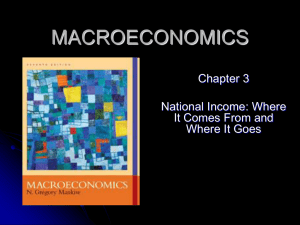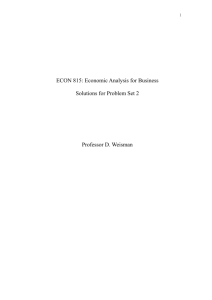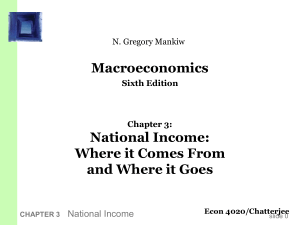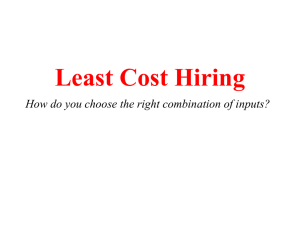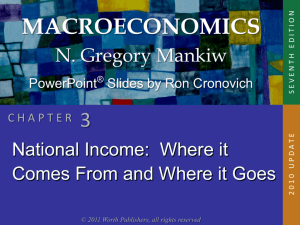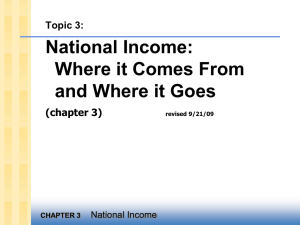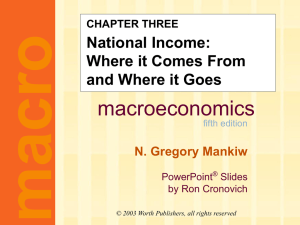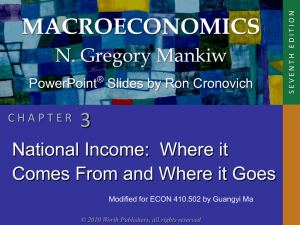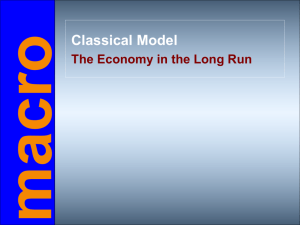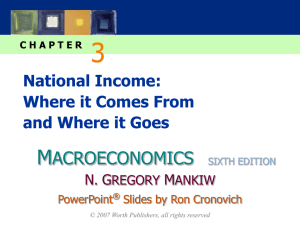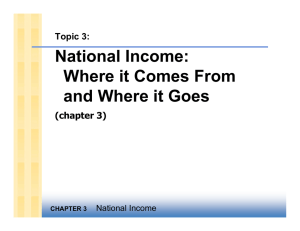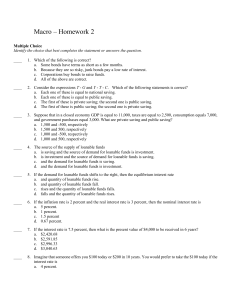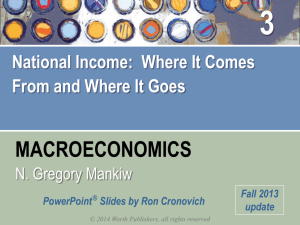Mankiw 6e PowerPoints
advertisement
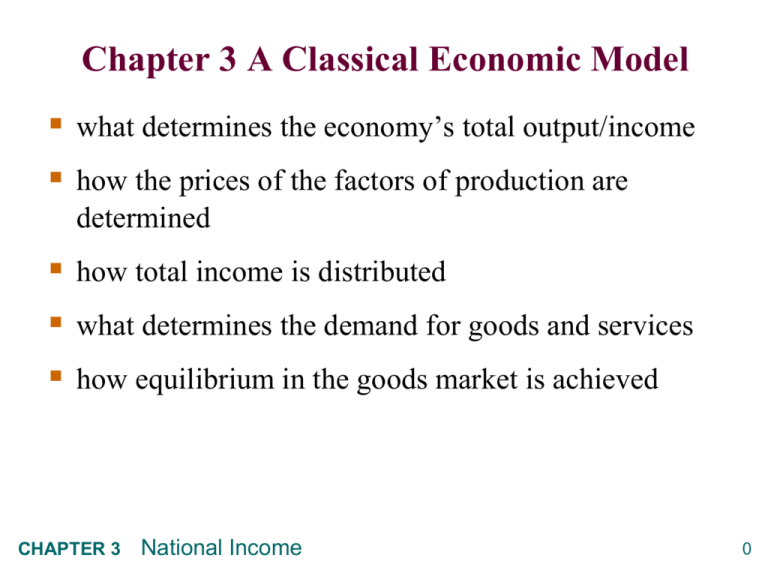
Chapter 3 A Classical Economic Model what determines the economy’s total output/income how the prices of the factors of production are determined how total income is distributed what determines the demand for goods and services how equilibrium in the goods market is achieved CHAPTER 3 National Income 0 Economic models …are simplified versions of a more complex reality irrelevant details are stripped away assumptions are made …are used to show relationships between variables explain the economy’s behavior devise policies to improve economic performance CHAPTER 3 National Income 1 Endogenous vs. Exogenous Variables The values of endogenous variables are determined in the model. The values of exogenous variables are determined outside the model: the model takes their values & behavior as given. In the model of supply & demand for pizza, endogenous: P, Qd, Qs exogenous: Pm CHAPTER 3 National Income 2 CHAPTER 3 National Income Figure 1.4 How Models Work Mankiw: Macroeconomics, Seventh Edition Copyright © 2010 by Worth Publishers 3 Model Equilibrium There are usually two elements of model equilibrium Optimization Market clearing Examples Supply and demand Inflow and outflow CHAPTER 3 National Income 4 The Use of Multiple Models No one model can address all the issues we care about. For each new model, you should keep track of its assumptions which variables are endogenous, which are exogenous the questions it can help us understand, those it cannot CHAPTER 3 National Income 5 A Simplified Structure of the Economy Households Work and get paid Consume and save Pay taxes to the government Firm Decide on inputs and produce Pay out factor income Government Collect tax revenues and pay for government purchases CHAPTER 3 National Income 6 CHAPTER 3 National Income Figure 3.1 The Circular Flow of Dollars Through the Economy Mankiw: Macroeconomics, Seventh Edition Copyright © 2010 by Worth Publishers 7 Outline of the model - I Key Assumptions: A closed economy Flexible prices (long-run) Factors in fixed supply and fully utilized Perfect competition Market-clearing CHAPTER 3 National Income 8 Outline of the Model - II Supply side determination of Inputs Demand side determinants of C, I, and G Equilibrium goods market factor markets loanable funds market CHAPTER 3 National Income 9 Factors of Production K = capital: tools, machines, and structures used in production L = labor: the physical and mental efforts of workers CHAPTER 3 National Income 10 The production function: Y = F(K,L) shows how much output (Y ) the economy can produce from K units of capital and L units of labor capital: tools, machines, and structures used in production labor: the physical and mental efforts of workers reflects the economy’s level of technology CHAPTER 3 National Income 11 The Determination of Inputs CHAPTER 3 National Income 12 Notation W = nominal wage R = nominal rental rate P = price of output W /P = real wage (measured in units of output) R /P = real rental rate CHAPTER 3 National Income 13 Demand for labor Assume markets are competitive: each firm takes W, R, and P as given. Basic idea: A firm hires an extra unit of labor if the cost does not exceed the benefit. cost = real wage benefit = marginal product of labor CHAPTER 3 National Income 14 Marginal product of labor (MPL ) CHAPTER 3 National Income 15 MPL and the production function Y output F (K , L ) 1 MPL MPL As more labor is added, M P L ↓ 1 MPL 1 Slope of the production function equals M P L L labor CHAPTER 3 National Income 16 Example: MPL (units of output) Marginal Product of Labor 12 10 8 6 4 2 0 0 1 2 3 4 5 6 7 8 9 Labor (L) 10 Diminishing marginal returns As a factor input is increased, its marginal product falls (other things equal). Intuition: Suppose ↑L while holding K fixed ⇒ fewer machines per worker ⇒ lower worker productivity CHAPTER 3 National Income 18 MPL and the Demand for Labor Units of output Each firm hires labor up to the point where MPL = W/P. Real wage MPL , Labor demand Units of labor, L Quantity of labor demanded CHAPTER 3 National Income 19 How factor prices are determined Factor prices are determined by supply and demand in factor markets. Recall: Supply of each factor is fixed. CHAPTER 3 National Income 20 The equilibrium real wage Units of output Labor supply equilibrium real wage MPL , L CHAPTER 3 National Income The real wage adjusts to equate labor demand with supply. Labor demand Units of labor, L 21 Determining the rental rate We have just seen that MPL = W/P. The same logic shows that MPK = R/P: diminishing returns to capital: MPK ↓ as K ↑ The MPK curve is the firm’s demand curve for renting capital. Firms maximize profits by choosing K such that MPK = R/P. CHAPTER 3 National Income 22 The equilibrium real rental rate Units of output Supply of capital The real rental rate adjusts to equate demand for capital with supply. equilibrium R/P K CHAPTER 3 National Income MPK, demand for capital Units of capital, K 23 Determining GDP Given the production function the assumption of full utilization Output is determined by the fixed factor supplies and the fixed state of technology: Y = F (K , L ) CHAPTER 3 National Income 24 The Neoclassical Theory of Distribution states that each factor input is paid its marginal product a good starting point for thinking about income distribution CHAPTER 3 National Income 25 How income is distributed to L and K W = MPL × L L total labor income = P R K MPK × K total capital income = = P If production function has constant returns to scale, then Y= national income CHAPTER 3 National Income MPL × L + MPK × K labor income capital income 26 The ratio of labor income to total income in the U.S., 1960-2007 Labor’s 1.0 share of total 0.8 income 0.6 0.4 0.2 Labor’s share of income is approximately constant over time. (Thus, capital’s share is, too.) 0.0 1960 1965 1970 1975 1980 1985 1990 1995 2000 2005 The Cobb-Douglas Production Function The Cobb-Douglas production function has constant factor shares: α = capital’s share of total income: capital income = MPK x K = α Y labor income = MPL x L = (1 – α )Y The Cobb-Douglas production function is: α 1−α Y = AK L where A represents the level of technology. CHAPTER 3 National Income 28 The Cobb-Douglas Production Function Each factor’s marginal product is proportional to its average product: αY MPK α= AK L = K (1 − α )Y α −α MPL = (1 − α ) A K L = L α −1 1−α CHAPTER 3 National Income 29 Labor productivity and wages Theory: wages depend on labor productivity U.S. data: CHAPTER 3 period productivity growth real wage growth 1959-2007 2.1% 2.0% 1959-1973 2.8% 2.8% 1973-1995 1.4% 1.2% 1995-2009 2.6% 2.3% National Income 30 Outline of model A closed economy, market-clearing model Supply side DONE factor markets (supply, demand, price) DONE determination of output/income Demand side Next determinants of C, I, and G Equilibrium goods market loanable funds market CHAPTER 3 National Income 31 Demand for goods & services Components of aggregate demand: C = consumer demand for goods & services I = demand for investment goods G = government demand for goods & services (closed economy: no NX ) CHAPTER 3 National Income 32 Consumption, C Def: Disposable income is total income minus total taxes: Y – T. Consumption function: C = C (Y – T ) Shows that ↑(Y – T ) ⇒ ↑C Def: Marginal propensity to consume (MPC) is the change in C when disposable income increases by one dollar. CHAPTER 3 National Income 33 The consumption function C C (Y – T ) MPC 1 The slope of the consumption function is the MPC. Y–T CHAPTER 3 National Income 34 Investment, I The investment function is I = I (r ), where r denotes the real interest rate, the nominal interest rate corrected for inflation. The real interest rate is the cost of borrowing the opportunity cost of using one’s own funds to finance investment spending So, ↑r ⇒ ↓I CHAPTER 3 National Income 35 The investment function r Spending on investment goods depends negatively on the real interest rate. I (r ) I CHAPTER 3 National Income 36 Government spending, G G = gov’t spending on goods and services. G excludes transfer payments (e.g., social security benefits, unemployment insurance benefits). Assume government spending and total taxes are exogenous: = G G= and T T CHAPTER 3 National Income 37 The market for goods & services Aggregate demand: C (Y − T ) + I (r ) + G Aggregate supply: Y = F (K , L ) Equilibrium: Y = C (Y − T ) + I (r ) + G The real interest rate adjusts to equate demand with supply. CHAPTER 3 National Income 38 The loanable funds market A simple supply-demand model of the financial system. One asset: “loanable funds” demand for funds: investment supply of funds: saving “price” of funds: real interest rate CHAPTER 3 National Income 39 Demand for funds: Investment The demand for loanable funds… comes from investment: Firms borrow to finance spending on plant & equipment, new office buildings, etc. Consumers borrow to buy new houses. depends negatively on r, the “price” of loanable funds (cost of borrowing). CHAPTER 3 National Income 40 Loanable funds demand curve r The investment curve is also the demand curve for loanable funds. I (r ) I CHAPTER 3 National Income 41 Supply of funds: Saving The supply of loanable funds comes from saving: Households use their saving to make bank deposits, purchase bonds and other assets. These funds become available to firms to borrow to finance investment spending. The government may also contribute to saving if it does not spend all the tax revenue it receives. CHAPTER 3 National Income 42 Types of saving private saving = (Y – T ) – C public saving = T – G national saving, S = private saving + public saving = (Y –T ) – C + T – G = CHAPTER 3 Y – C – G National Income 43 Budget surpluses and deficits If T > G, budget surplus = (T – G ) = public saving. If T < G, budget deficit = (G – T ) and public saving is negative. If T = G , “balanced budget,” public saving = 0. The U.S. government finances its deficit by issuing Treasury bonds – i.e., borrowing. CHAPTER 3 National Income 44 Loanable funds supply curve r S =Y − C (Y − T ) − G National saving does not depend on r, so the supply curve is vertical. S, I CHAPTER 3 National Income 45 Loanable funds market equilibrium r S =Y − C (Y − T ) − G Equilibrium real interest rate I (r ) Equilibrium level of investment CHAPTER 3 National Income S, I 46 The special role of r r adjusts to equilibrate the goods market and the loanable funds market simultaneously: If L.F. market in equilibrium, then Y–C–G =I Add (C +G ) to both sides to get Y = C + I + G (goods market eq’m) Thus, Eq’m in L.F. market CHAPTER 3 National Income ⇔ Eq’m in goods market 47 CASE STUDY: The Reagan deficits Reagan policies during early 1980s: increases in defense spending: ∆G > 0 big tax cuts: ∆T < 0 Both policies reduce national saving: S =Y − C (Y − T ) − G ↑G ⇒ ↓ S CHAPTER 3 National Income ↓T ⇒ ↑ C ⇒ ↓ S 48 CASE STUDY: The Reagan deficits 1. The increase in the deficit reduces saving… 2. …which causes the real interest rate to rise… 3. …which reduces the level of investment. CHAPTER 3 National Income r S 2 S1 r2 r1 I (r ) I2 I1 S, I 49 Are the data consistent with these results? variable 1970s 1980s T–G –2.2 –3.9 S 19.6 17.4 r 1.1 6.3 I 19.9 19.4 T–G, S, and I are expressed as a percent of GDP All figures are averages over the decade shown. CHAPTER 3 National Income 50 Chapter Summary Total output is determined by: the economy’s quantities of capital and labor the level of technology Competitive firms hire each factor until its marginal product equals its price. If the production function has constant returns to scale, then labor income plus capital income equals total income (output). CHAPTER 3 National Income 51 Chapter Summary A closed economy’s output is used for: consumption investment government spending The real interest rate adjusts to equate the demand for and supply of: goods and services loanable funds CHAPTER 3 National Income 52 Chapter Summary In the benchmark model, real variables are determined in the real economy. Changes in money supply have no impact on the final output or the real interest rate. In the benchmark model, changes in government spending or taxes have no impact on the final output. However, such changes affect the real interest rate and the composition of output. CHAPTER 3 National Income 53
